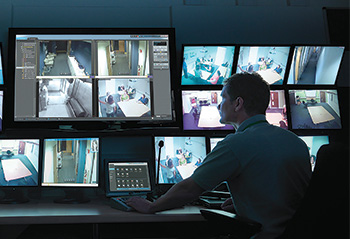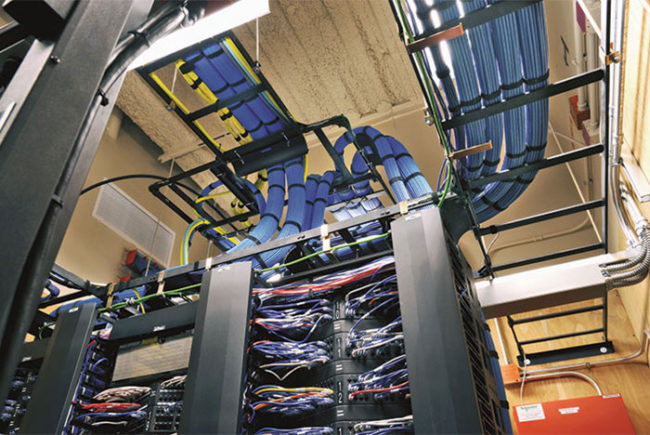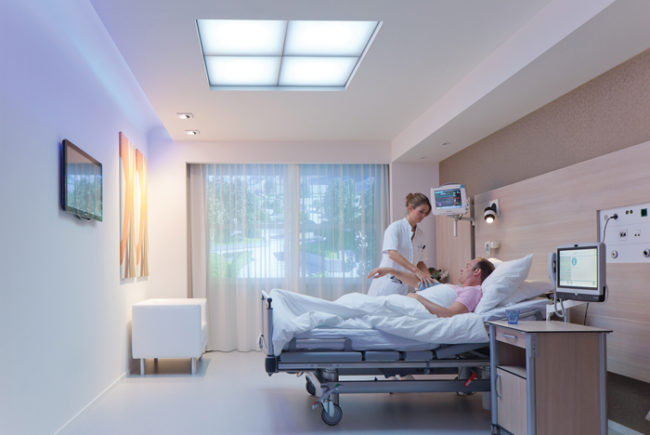 |
| Some auxiliary systems, such as close circuit television, will not physically interact with medical staff or visitors very often. |
Changes in building systems technology have created a demand for more information delivered faster to one location. Oftentimes, this demand or need is critical, especially in the workplace.
The health care field is one area where a convergence of many key infrastructure systems is helping to provide critical information quickly and concisely on a daily basis.
Merging for performance
A hospital’s life safety and security system includes many individual auxiliary systems: fire suppression or clean agent; fire detection; generator monitoring; elevator control; heating, ventilation and air-conditioning (HVAC); access control; closed circuit television (CCTV); intrusion detection; nurse call; infant protection; wandering patient; and notification systems. All of these systems serve a specific purpose in the ongoing operation of a health care facility.
You may also like |
| Medical grade wireless infrastructures |
| Infrastructures for off-campus operations |
| Technology system commissioning |
| |
Staff and patients use many of these systems, such as nurse call, on a daily basis. Other systems, such as fire alarm and security, may not experience interaction from the medical staff or visitors that often. Nevertheless, each system needs to be continually inventoried and maintained.
Life safety and security systems must be in place and up-to-date, function quickly and accurately, and provide information in a timely manner. Compliance with codes and regulations for these systems, and the need for worker and patient security, place a burden on hospitals to continually monitor the technological changes within these areas.
Of course, there is a cost involved with implementing these updates and, because life safety and security systems are non-revenue generating, health care facilities often have a limited budget to incorporate upgrades to these systems. Still, the convergence of life safety and security systems is a way to provide a return on investment, reduce costs of maintenance and staffing, stay current on the ever-changing technologies and increase the flow of information.
The advantages of merging auxiliary systems already are being seen. According to the National Fire Protection Association, the number of hospital fires has dropped significantly from 3,210 in 1989 to 1,200 in 2010. A few noted reasons for the decrease are that staff emergency training has improved, smoking is no longer permitted with the exception of specific circumstances that require Joint Commission approval, and fire alarm systems are being linked to other systems within the hospital.
Fire alarm systems control the elevators when a hazard has been detected. In addition, they are linked to the HVAC and building automation system to control smoke and monitor suppression systems for alarm activation. Voice notification systems are becoming more common as a way to provide instructions to staff as they initiate emergency plans, including sheltering in place, partial evacuation or even a full evacuation in extreme circumstances.
Likewise, emergency communication systems allow first responders the ability to provide current information to staff and visitors during the relocation process. In addition, life safety and security systems are being integrated to ensure that critical emergency alarm information is transmitted to first responders prior to their arrival on the scene. With the ability to receive not only a phone call from the monitoring station, but also photos and video of the emergency event, municipalities have additional time to prepare their response plans. During these events, minutes and even seconds can affect the outcome.
Standard procedure requires that a security officer be dispatched when a fire or security alarm occurs. This could be a door forced open in the access control system, a duress alarm from the security system, an infant monitor alarm or a sprinkler gate valve tamper from the fire alarm system. Having an officer inspect an alarm is protocol to provide visual confirmation of the incident — a step that can take time, especially as facilities grow to accommodate multiple services.
Integrating the life safety, security and patient call systems with a facility’s CCTV system allows officers to visually inspect the area where the alarm occurred from the security command center, and direct the officers to the specific location. This is especially critical if personnel are away from the site of the incident. By incorporating other auxiliary system alarms (i.e., nurse call, infant protection and patient wandering) these events can be visually verified and the area locked down, as long as the CCTV coverage is sufficient.
Another notable process improved by a complete convergence of life safety and security systems is communication between medical and security staff. If a patient, visitor or employee wanders into an unauthorized area, exits the facility or tampers with medical equipment, all auxiliary systems working together can transmit critical information strategically throughout the facility. Much of this integration has been enabled by information technology (IT) advances.
Finally, another advantage of having all auxiliary systems under one platform is the ability to store the history and events for each system. Prior to the convergence of systems, life safety and security systems event storage was limited to the event buffer contained within each system. With the integration of external storage devices and systems, the parameters change from storing only a finite number of records to a nearly unlimited number.
With the integration of systems, events that were stored and overwritten on a first-in/first-out basis now can be filtered, sorted and stored for as long as needed or required. If a facility’s policy is to keep a month’s worth of CCTV events, a year’s worth of access control events and every life safety event, the storage device now can be sized to accommodate current and future needs.
Tracking and saving events and responses ensures that proper protocol is being met, and decreases facility liability in the event of a lawsuit or claim. And with the addition of network video recorders, multiple personnel can be given access, no matter where they are located within the facility or organization.
IT into the mix
Security and maintenance personnel are leveraging a building’s existing network infrastructure whenever possible. Auxiliary systems are quickly becoming Internet protocol (IP) addresses on facilities’ networks. Utilizing the local area network that is already in place saves time and materials related to the installation, expansion and integration of auxiliary systems.
Facility networks quickly transmit multiple levels of information with varying levels of importance over large areas to numerous people. The result is information transmitted to precise staff members, enabling them to act quickly.
Earlier generations of life safety and security systems relied on cables running from head-end equipment to all of its associated devices. Now, devices and panels can be assigned an IP address and routed to the appropriate head-end location.
For instance, IP cameras can be added to areas lacking coverage without the need for dedicated cabling. Likewise, IP intercom stations now can be installed on secured doors to help decrease the flow of personnel through critical areas. And duress buttons and access control card readers can wire back to an IP-based security control panel to allow system expansion into areas requiring additional protection.
Furthermore, these devices and the information they generate can be routed to the appropriate departments for review and response as required. Health care facilities need to be aware that the use and expansion of the IT network has created a need for close coordination between the facilities and IT departments.
One might worry that merging auxiliary systems and potential patient information might violate Health Insurance Portability and Accountability Act (HIPAA) requirements. In actuality, hospitals can remain in compliance by collaborating with the human resources (HR) department. Integrating the patient database into the facility's security systems provides a foundation upon which all systems can build.
HR serves as the primary source for inputting a patient’s information into the system, creating a profile for each patient that is pushed out to the patient recording systems and the access control system, which eliminates the need for dual entry and minimizes the potential for incorrect data entry.
Specific patient information can be filtered out, keeping the facility in compliance with HIPAA, but allowing a unification of necessary data. While this system convergence saves the facility both time and money, coordination between departments is required so that only the needed information is provided.
Other challenges
While there are numerous advantages to integrating life safety and security systems, there are some disadvantages due to a rewrite of the 2012 edition of the National Fire Protection Association’s NFPA 99, Health Care Facilities Code, which is now based on the application of risk-based assessments, not just the occupancy type.
The assessments are based on the types of procedures being performed, the systems in place and the equipment within the facility. Thus, more departments and personnel need to be involved with the design of a building and its components. Also, an increased number of inspections need to occur prior to a facility’s gaining occupancy.
As it stands, the health care facility industry must gain approvals from multiple authorities such as the Joint Commission, state fire marshal and the local building inspector. With the integration of additional building auxiliary systems comes the need to gain approvals from various local inspectors as well.
However, auxiliary system integration has yet to reach its full potential.
For instance, facial recognition is in its infancy. Once all of the imperfections are worked out, it will be available for incorporation into a facility’s CCTV system. This will enhance the ability to determine patient location, pair infant and parent, grant visitor access to patient rooms and survey for people on the government’s most wanted list.
CCTV analytics will continue to expand and advance, providing security personnel the ability to set up virtual zones of protection, and get automatic alerts when these zones are breached.
Integration to smartphones and tablets also has tremendous potential. Radio-frequency identification could be used to help families keep up-to-date with the progress of a loved one’s medical procedure. It also could be used as a credential to gain access through a secure door, to purchase food from the cafeteria or vending machine, or even view the patient via a CCTV camera.
Providing information
The goal of converging auxiliary systems is to provide high-quality information in less time to those who need it, thereby improving the chances of saving lives and property.
The use of a hospital’s network to combine its fire suppression, fire detection, access control, CCTV, intrusion, nurse call, infant protection, wandering patient notification and other systems gives health care facilities the opportunity to achieve this objective.
Everyone from the organization’s IT and security staff, HR department, facilities group and design team need to plan how each system will work together.
John Delaney and Mark Smith are data/fire/security system designers at SSOE Group, an engineering, procurement and construction management firm. They can be reached at John.Delaney@ssoe.com and Mark.Smith@ssoe.com, respectively.





